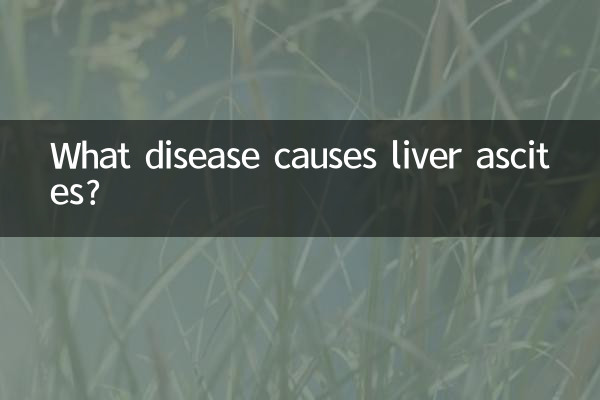What disease causes liver ascites?
Hepatic ascites, also known as cirrhotic ascites, is one of the common complications in the late stages of liver cirrhosis. It mainly manifests as excessive fluid accumulation in the abdominal cavity, leading to symptoms such as abdominal distension and difficulty breathing. The occurrence of hepatic ascites is related to many diseases, especially liver disease. This article will combine the hot topics and hot content in the past 10 days to provide a detailed analysis of the causes, symptoms, diagnosis and treatment of hepatic ascites.
1. The main causes of liver ascites

The occurrence of hepatic ascites is usually closely related to the following diseases or factors:
| Cause | illustrate |
|---|---|
| Cirrhosis | The most common cause, accounting for more than 80% of cases of hepatic ascites. Cirrhosis leads to portal hypertension, causing ascites. |
| hepatitis | If chronic hepatitis B or C is not treated in time, it may develop into cirrhosis, which may lead to ascites. |
| alcoholic liver disease | Long-term excessive drinking causes liver damage, which may eventually develop into hepatic ascites. |
| liver cancer | Liver tumors may compress blood vessels or metastasize to the peritoneum, possibly causing ascites. |
| cardiac insufficiency | Right heart failure leads to obstruction of blood return, causing liver congestion and ascites. |
| nephrotic syndrome | Hypoalbuminemia results in a decrease in plasma osmolality and fluid leakage into the abdominal cavity. |
2. Typical symptoms of liver ascites
Symptoms of hepatic ascites vary depending on the severity of the condition. Common manifestations include:
| symptom | describe |
|---|---|
| Abdominal distension | The abdomen gradually enlarges, and in severe cases, it looks like a frog belly. |
| weight gain | Significant weight gain in the short term is related to ascites accumulation. |
| difficulty breathing | Ascites compresses the diaphragm and affects respiratory function. |
| Abdominal bloating and discomfort | Patients often feel abdominal fullness or dull pain. |
| Lower limb edema | Lower extremity edema may occur when combined with hypoalbuminemia. |
3. Diagnostic methods of hepatic ascites
The diagnosis of hepatic ascites requires a combination of clinical manifestations and auxiliary examinations:
| Check items | significance |
|---|---|
| abdominal ultrasound | It can detect the amount of ascites and changes in liver morphology. |
| Ascites puncture | Ascites fluid is extracted for testing to distinguish transudate from transudate. |
| liver function test | Assess hepatic anabolic and metabolic function. |
| CT/MRI | Comprehensive assessment of the extent and cause of liver disease. |
| Portal vein pressure measurement | Directly assess the degree of portal hypertension. |
4. Treatment plan for liver ascites
Treatment of hepatic ascites requires comprehensive management of the cause and symptoms:
| Treatment | Specific measures |
|---|---|
| sodium restricted diet | Keep daily sodium intake below 2g to reduce water and sodium retention. |
| diuretic therapy | Spironolactone combined with furosemide is commonly used, and electrolytes need to be monitored. |
| Ascites puncture | When there is a large amount of ascites, puncture can be performed to drain the fluid and albumin can be supplemented at the same time. |
| TIPS surgery | Transjugular intrahepatic portosystemic shunt to reduce portal pressure. |
| liver transplant | The ultimate treatment for end-stage liver disease. |
5. Hot discussions on hepatic ascites in the past 10 days
According to recent hot topics on the Internet, public concern about hepatic ascites mainly focuses on the following aspects:
| hot topics | Discussion points |
|---|---|
| early identification | How to detect the risk of liver ascites early through everyday symptoms. |
| Diet management | Dietary taboos and recommended recipes for patients with hepatic ascites. |
| Traditional Chinese Medicine Conditioning | The role of traditional Chinese medicine in the adjuvant treatment of liver ascites. |
| New drug progress | Latest research on targeted drugs in the treatment of liver cirrhosis. |
| Medical insurance policy | Medical insurance reimbursement of liver disease-related treatment costs. |
6. Recommendations for preventing liver ascites
The key to preventing hepatic ascites is to protect liver health:
1. Avoid excessive drinking to reduce alcohol damage to the liver.
2. Regular physical examination, especially for those with a history of hepatitis or family liver disease.
3. Standardize the treatment of chronic liver disease to prevent the disease from progressing to cirrhosis.
4. Maintain a healthy weight and prevent non-alcoholic fatty liver disease.
5. Use drugs with caution and avoid the abuse of hepatotoxic drugs.
Hepatic ascites is a symptom of severe liver disease. Once relevant symptoms appear, you should seek medical treatment in time. Through standardized treatment and scientific management, the symptoms of most patients can be effectively controlled. The public should improve their understanding of liver disease and achieve early prevention, early detection and early treatment.

check the details

check the details